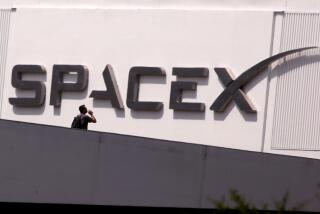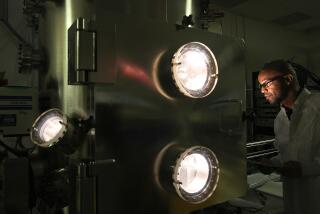Aerospace Corp. Plans For-Profit Conversion
- Share via
Aerospace Corp., created by the federal government as a nonprofit defense research lab during the Cold War, will transform itself into a for-profit corporation by merging with Science Applications International Corp. in a deal worth more than $200 million, the two firms said Tuesday.
If the merger takes place as proposed, El Segundo-based Aerospace--one of dozens of contractors created by Congress at the Pentagon’s request to perform engineering analysis for the military--would lose its privileged status as an Air Force contractor and would have to compete with private firms for public work.
But the change would also free Aerospace of the need to justify its funding before Congress, which has been applying increasing scrutiny to so-called Federally Funded Research and Development Centers, or FFRDCs, such as Aerospace. A merger would further allow Aerospace to compete for private contracts in the emerging commercial space industry.
Aerospace and Science Applications, a San Diego-based research and engineering firm, said they signed a letter of intent to engage in further talks aimed at a merger on Jan. 31. Any deal would have to be approved by Science Applications’ employees, who own the firm, as well as the board of Aerospace, the Air Force and the secretary of defense.
Among the issues still to be worked out is how much compensation would be owed to the Air Force by the merged companies. Because Aerospace is a private, nonprofit firm, the government would receive no direct financial gain from the transaction, acknowledged Darleen Druyun, the Air Force’s principal deputy assistant secretary in charge of acquisitions. But the service, which accounts for more than 90% of Aerospace’s business, may have some claim to compensation for its costs of terminating its sponsorship of Aerospace. Druyun declined to estimate the amount.
Under the terms of the proposed deal, SAIC would invest more than $200 million in Aerospace to fund new research and development and to provide stock in the combined companies to Aerospace’s employees, President and Chief Executive Edward C. “Pete” Aldridge Jr. said in an interview.
Aldridge, a former secretary of the Air Force, said the merger would allow his company to overcome problems arising from its close links to the government.
“For the last five years, [we’ve seen] a decline in support of FFRDCs by the government and Congress, which has affected the morale and long-term goals of the corporation,” he said.
For its part, however, the Air Force is concerned that the merger may mean the loss of its main space engineering expertise, potentially higher costs and possible conflicts of interest, Druyun said.
Fear of such conflicts of interest was what prompted the government in 1960 to create Aerospace by spinning off the systems engineering unit of TRW Inc. The idea was to place some distance between engineers who were making recommendations on high-tech hardware and the manufacturers of the same hardware, said Rechtin Eberhardt, Aerospace’s president emeritus.
NASA Administrator Daniel S. Goldin, whose agency accounts for about 3.5% of Aerospace’s business, applauded the proposed deal.
“It took a tremendous amount of courage for these two companies to get together and say they no longer want to do sole-source work anymore,” he said, referring to Aerospace’s reliance on a single customer. “I hope this is the beginning of a trend in the systems engineering field.”
SAIC has 22,000 employees in 475 locations and sales of more than $2 billion. Aerospace has 3,000 employees and offices in California, Virginia, Texas, Colorado and New Mexico.
Aerospace has been scrutinized in recent years by federal officials concerned about the amount of taxpayer money pouring into the lab.
Among other things, a confidential 1994 Pentagon audit found that the firm awarded raises averaging 22% to 29% to top managers even as it was laying off technical staff. Aerospace disputed the accuracy of those figures but contended that hefty raises were needed in any case to enable the firm to compete with private companies in the field.
More recently, the firm and others like it have been the subject of congressional hearings on the wisdom of continuing the program of federally funded research firms.
Part of the pressure has come from private firms eager to compete for contracts that are now awarded without bidding to Aerospace and other FFRDCs.
More to Read
Inside the business of entertainment
The Wide Shot brings you news, analysis and insights on everything from streaming wars to production — and what it all means for the future.
You may occasionally receive promotional content from the Los Angeles Times.










